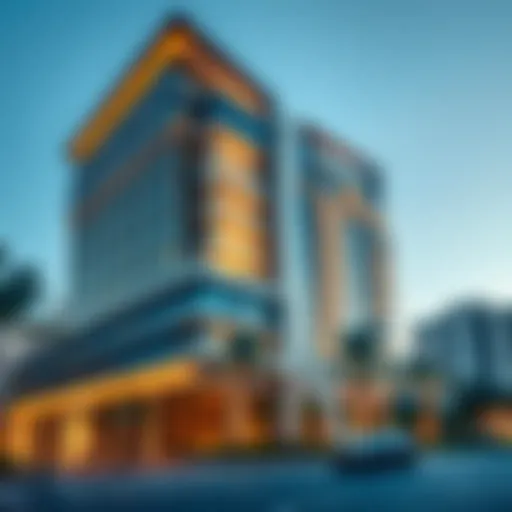Dubai's Bold Construction Projects Shaping the Future


Intro
Dubai’s skyline is a stunning testament to human ingenuity and ambition, constantly reshaping itself to accommodate a myriad of dreams and aspirations. As the city transcends its origins, emerging from a desert landscape into a thriving urban oasis, the construction projects that arise reflect not only architectural prowess but also socio-economic shifts. Investors and home buyers alike find themselves at a critical juncture where understanding recent developments is paramount.
The upcoming sections will delve into the latest construction initiatives underway in Dubai, shining a light on their significance in today’s real estate market. With the city’s development trajectory showcasing both resilience and innovation, it is essential to examine market trends, investment insights, and what the future holds for this remarkable metropolis. Whether you're an investor eying new opportunities or a resident contemplating where to plant roots, the evolution of Dubai’s infrastructure is a narrative worth following closely.
Overview of Dubai's Construction Boom
Dubai is often seen as the architectural playground of the Middle East. Over the years, the city’s skyline has transformed dramatically, from humble beginnings to a cluster of gleaming towers and lavish developments. This metamorphosis has not merely shaped the aesthetics, but it also signifies an ongoing economic shift and globalization remarkable in its scale. The construction boom in Dubai, at its core, is emblematic of the city’s ambitions to become a global hub for finance, tourism, and culture.
The significance of this construction saga lies in its multi-faceted benefits and considerations. Firstly, it creates a ripple effect across various sectors of the economy. The extensive construction initiatives lead to job creation, boosting local employment opportunities in roles ranging from laborers to project managers. Additionally, each skyscraper and megaproject underlines a deeper investment into sustainable and resilient infrastructures, which in turn attracts foreign investment. Developers and investors are keenly eyeing this blossoming landscape, foreseeing substantial returns on investment.
Moreover, with new construction, planners and architects engage with innovative designs and technologies that enhance livability. From smart homes to eco-friendly buildings, these trends reflect modern sensibilities and a response to global environmental challenges. By addressing the pressing issues of sustainability and urbanization, Dubai showcases its willingness to adapt and evolve.
However, this rapid growth is not without its challenges. With the ongoing influx of people and projects, issues of infrastructural strain, regulatory compliance, and supply chain snarls can arise. Thus, understanding this construction boom presents an intricate blend of opportunity and challenge for those directly involved and for the general populace.
The following sections of the article will delve into the historical context that set the stage for this boom, along with the driving forces catalyzing recent developments. By dissecting these elements, we’ll provide nuanced insights that illuminate the ongoing trajectory of Dubai’s construction sector, to comprehensively grasp what the future holds for the city.
Key Construction Projects Currently Underway
Dubai's construction projects are more than just buildings. They are reflections of ambition, creativity, and economic strategies manifesting in brick and mortar. Understanding these key construction initiatives offers invaluable insights into the evolving dynamics of the city, especially for investors, home buyers, and property managers.
Mixed-Use Developments
Mixed-use developments are carving out a new niche in Dubai's urban landscape. They serve diverse purposes—residential, commercial, and recreational—all under one roof. This blend is practical, as it reduces the need for long commutes, enabling residents to access amenities within walking distance. Projects like Dubai Creek Harbour exemplify this trend, promising a vibrant community that embraces social interaction while minimizing the carbon footprint.
"Mixed-use developments represent not just a residential space, but a lifestyle approach that could attract families and professionals alike."
A considerable benefit of such projects is their potential for revitalizing neighborhoods. They signify a shift toward sustainability, reducing traffic congestion and encouraging community living. Investors view these developments as advantageous due to their appeal to a broader demographic, ensuring good occupancy rates and stable returns.
Residential Towers
The skyline of Dubai is punctuated with ambitious residential towers. Each building tells a story of luxurious living, catering to a growing population attracted to the allure of this dynamic city. Projects like the Villa Riviera or the upcoming Dubai Marina Residential Towers showcase design innovations and high-end facilities, appealing to both affluent buyers and expatriates.
Residential towers are designed with modern lifestyles in mind. Features often include smart home integrations, eco-friendly designs, and communal facilities like pools and gyms. The critical question for buyers and investors is whether these towers meet the increasing demand for high-quality living spaces in an ever-competitive market.
Additionally, the strategic locations of these towers play a significant role in their desirability. Proximity to commercial hubs, access to public transport, and nearby leisure facilities can significantly influence property value. So, when considering a purchase or investment, it’s vital to analyze the location dynamics as much as the tower’s specifications.
Commercial Spaces
In tandem with residential growth, commercial spaces are undergoing a transformation. Areas like Business Bay are burgeoning with new office buildings, co-working spaces, and retail outlets. This evolution is crucial for fostering economic growth, encouraging entrepreneurship, and enhancing the overall business climate in Dubai.
Commercial projects are increasingly integrating vital amenities that cater to the needs of modern businesses. Features such as flexible office layouts, green spaces, and state-of-the-art technology are becoming the norm.
A noteworthy project is the Dubai World Trade Centre expansion, which aims to support the region’s rise as a global business hub. The potential for economic diversification makes these spaces particularly attractive to investors looking to benefit from Dubai’s ongoing expansion. By focusing on emerging trends within commercial real estate, buyers can position themselves advantageously in a promising market.
As Dubai continues to expand, the key construction projects underway are pivotal not only for shaping its skyline but also for influencing the real estate landscape, economic growth, and community dynamics in the city.
Innovative Architectural Designs
The construction landscape in Dubai is not just about erecting structures; it's about weaving together innovation and artistry in ways that resonate with the city’s spirit. Innovative architectural designs play a pivotal role in shaping these projects, offering several important benefits that affect not only aesthetics but also functionality and sustainability.
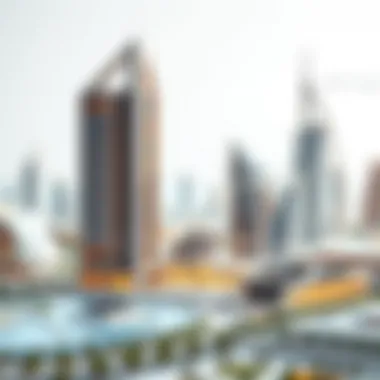
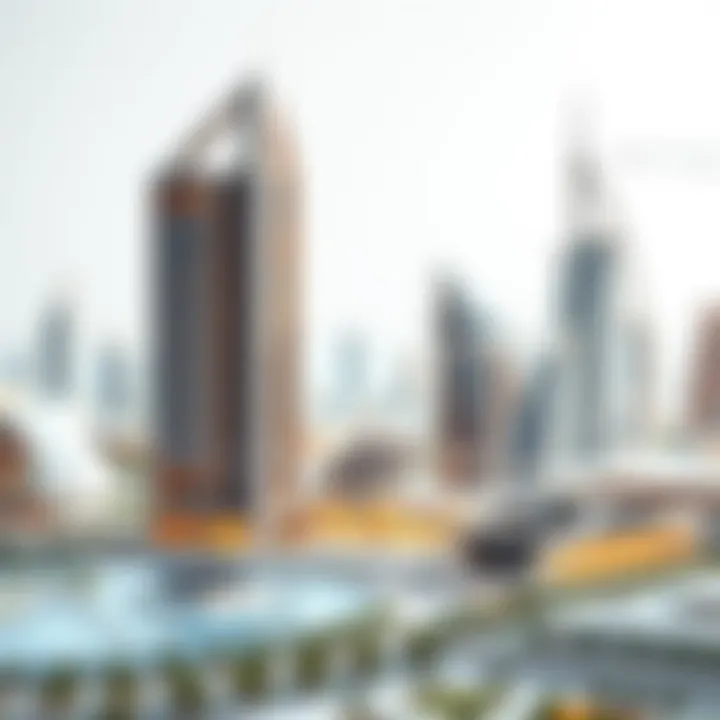
Sustainability in Construction
In recent years, the emphasis on sustainability has exploded in the construction sector. Architects are now challenged to harmonize modern designs with environmentally friendly practices. Take, for instance, the recent push towards the use of local materials, which reduces carbon footprints significantly. Eco-friendly buildings, like The Sustainable City, showcase energy-efficient designs that allow them to thrive amidst the urban sprawl. This approach not only cuts down on energy usage but leaves less waste in its wake.
Moreover, smart water management systems are being integrated into many new projects. These systems recycle waste water and collect rainwater, helping manage the resource in a city where water scarcity is a growing concern. The rise of vertical gardens and green roofs, which provide insulation and reduce heat, also exemplifies the trend towards sustainable architecture. In this way, sustainability is not merely a box to check off; it's becoming an essential element that influences how developments are conceived and constructed.
Smart Technology Integration
Getting a foothold on modern technology is another game changer for Dubai’s innovative architectural designs. Smart technology has made considerable inroads into the construction process, providing incredible opportunities for optimization. One particularly notable development is the incorporation of Building Information Modeling (BIM). This technology allows architects and engineers to create digital representations of physical buildings. Think of it as planning your route on a map before hitting the road; BIM helps visualize potential issues far ahead of time.
Not only does this streamline the design process, but it also fosters collaboration among various stakeholders, allowing for adjustments in real-time. Additionally, integrating smart technologies such as IoT devices into the design of buildings enhances automation, improves energy management, and optimizes the overall user experience. For example, lighting systems that adjust based on human presence or weather conditions are becoming increasingly common.
"The future does not wait; it embodies the present within its innovative strides." - Unknown
For more insights on smart technology and sustainable practices in construction, you might find these resources helpful:
- Sustainability in Construction and Green Building
- Architectural Automation and Smart Buildings
- Construction Tech Insights
Investment in such transformative designs is not just an economic decision; it’s a roadmap toward a new era of urban living.
Regulatory Considerations
Regulatory considerations play a crucial role in shaping the construction landscape in Dubai. With its rapid development, ensuring adherence to laws and standards not only streamlines project execution but also safeguards the interests of investors, home buyers, and the broader community. A strong regulatory framework maintains quality and boosts the city’s reputation as a major global hub. It fosters investor confidence and helps in managing various risks associated with construction ventures.
Building Codes and Standards
Building codes and standards in Dubai are the backbone of any construction project. These regulations dictate everything from safety measures and design practices to materials used. The Dubai Municipality sets forth comprehensive codes designed to assure structural integrity and safety. Understanding these codes is essential for all parties involved:
- Safety First: Building codes enforce safety standards that help prevent accidents and disasters. Without such measures, the integrity of buildings and the well-being of residents could be compromised.
- Sustainability Practices: The regulations increasingly emphasize sustainability, aiming to minimize the environmental footprint of developments. For instance, using energy-efficient materials and green technologies not only meets regulatory requirements but also enhances the marketability of a project.
- Design Consistency: Following established codes ensures that various projects maintain a cohesive aesthetic, preserving Dubai's image as a modern metropolis.
Investors should familiarize themselves with specific requirements pertaining to the type of project they wish to undertake. Familiarizing oneself with these standards can significantly reduce the risk of compliance-related delays and additional expenses.
Licensing Requirements for Developers
Obtaining the necessary licenses is an unavoidable step for any developer in Dubai. These licenses not only signify compliance with the local laws but also protect stakeholders' investments. The licensing process is thorough and aimed at ensuring that only reputable firms undertake construction projects. Key aspects include:
- Verification of Skills and Experience: Licensing evaluates the competency of a developer. This process ensures that those who seek to build have the necessary experience and resources to complete the project efficiently.
- Financial Assessment: Developers must provide proof of financial viability to ensure that they can fund the construction and adhere to timelines. This consideration protects both the investors and the eventual buyers.
- Ongoing Compliance: Licensing isn't a one-and-done deal. Developers are required to maintain their licenses by meeting ongoing requirements, ensuring that they are accountable throughout the project lifecycle.
Navigating the licensing landscape can be daunting for newcomers. Partnering with a trusted local entity can often simplify the process, offering invaluable insights and guidance regarding the intricate regulatory environment.
"Understanding and adhering to regulatory frameworks is not just a requirement; it's a pathway to success in Dubai's construction sector."
Economic Impacts of Construction Projects
Understanding the economic ramifications of construction projects in Dubai is crucial. This sector doesn't just shape the skyline; it also profoundly influences the entire economic fabric of the city. From job creation to heightened property values, the construction landscape provides a multifaceted lens through which to view urban development.
Job Creation and Employment Trends
One of the most salient effects of Dubai's ongoing construction boom is job creation. As builders break ground on residential towers, commercial spaces, and mixed-use projects, there’s an undeniable surge in demand for labor. According to industry reports, thousands of jobs are often generated per major development, feeding the local economy and providing livelihoods for many.
This job growth is not limited to manual labor. Skilled positions in engineering, project management, and design are also in high demand. Additionally, the ripple effect on related sectors—like materials supply, transportation, and services—is significant. Local suppliers often benefit as developers seek materials for their projects, resulting in a collaborative ecosystem that bolsters livelihoods.
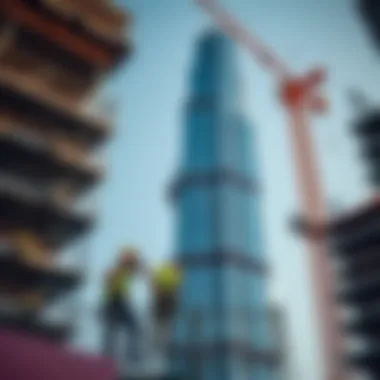
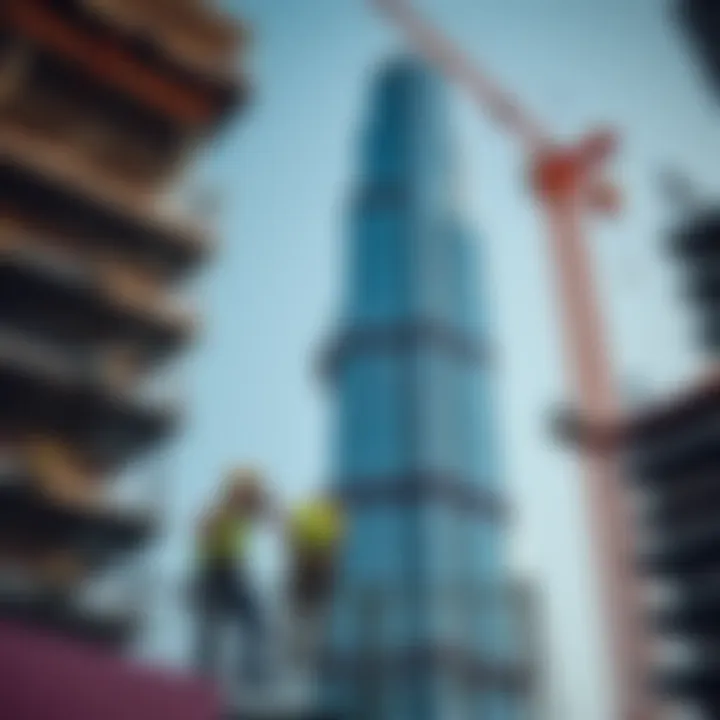
However, it's important to consider employment trends as well. As the global economy shifts, so do the needs of the workforce. Construction companies are increasingly focusing on retaining skilled labor and investing in training programs, aligning themselves with industry advancements. This inclination towards skilled labor ensures a transition from handyperson tasks to specialized roles, giving workers a pathway to growth in this dynamic environment.
Effects on Property Prices
The construction initiatives underway in Dubai also have profound implications on property prices. New developments often create a buzz in the real estate sector, and as these projects come to fruition, demand naturally spikes. This increase in demand can drive property values upward, reshaping the market landscape.
When plans for high-end residential complexes like The Palm Tower or commercial hubs emerge, they can elevate the surrounding areas. Investors keen on profiting from rising property values often proceed to buy in these regions, anticipating lucrative returns. This frenzy may lead to a cascading effect on other properties in the vicinity, as market perceptions shift and neighboring properties become seen as more valuable.
Furthermore, the influx of investors and homebuyers seeking the latest offerings in Dubai's vibrant real estate market leads to greater competition. Prices can surge rapidly, making it important for prospective buyers to keep a keen eye on market trends to make informed investment decisions.
"The construction sector serves as a solid backbone for Dubai's economy, influencing not just the physical skyline but every facet of daily life through job creation and real estate dynamics."
In summary, Dubai's construction projects create a robust ecosystem full of benefits but also potential pitfalls not to be overlooked. As the city pushes forward with its development plans, staying abreast of these intricate economic impacts will be key for investors, residents, and policy makers alike.
Challenges Facing the Construction Sector
The construction sector in Dubai, known for its ambitious projects and rapid development, faces significant challenges. Understanding these issues is paramount for investors, developers, and stakeholders, as they can significantly influence project timelines, costs, and overall feasibility. Recognizing challenges also allows for better planning and more informed investment decisions. The potential for both risk and reward hinges on navigating these hurdles effectively.
Supply Chain Disruptions
Supply chain disruptions have emerged as a critical issue in the construction industry, especially since the global pandemic. When one considers the vast array of materials and components required for a single project, it's clear how delicate the supply chain can be. The sources of disruption can be varied: natural disasters, geopolitical tensions, or even logistical delays can send ripples through the supply chain.
Many construction projects rely on materials from different parts of the world, including steel from China, concrete from various Middle Eastern suppliers, and even specialized equipment from Europe. When any link in this chain falters, it creates a domino effect, causing project delays and increased costs.
- Delay in projects can lead to a loss of potential rental income or sales, particularly for real estate investors.
- Cost overruns directly impact the bottom line, often forcing developers to reassess their budgets and timelines.
Mitigating these disruptions is crucial, but it requires a multifaceted approach. Developers might consider diversifying their suppliers or investing in local manufacturing options to reduce dependencies on international shipments.
Labor Shortages
Another pressing issue is the shortage of skilled labor. Despite Dubai's technological advancements, the real estate boom has outpaced the availability of qualified workers. This shortage can jeopardize the quality and speed of construction projects.
It's not just about finding bodies to fill positions; it’s about sourcing trained personnel capable of meeting the construction sector's specific demands. Workers who possess specialized skills—including knowledge of smart technologies, sustainable construction practices, and safety protocols—are in high demand.
- Skill gaps can lead to project delays, increased errors, and, ultimately, higher costs for developers and investors alike.
- Attractive compensation programs are necessary to entice skilled workers to the field, driving up operational costs further.
Training programs and partnerships with educational institutions may offer a path forward, but these solutions require time and commitment which can delay project timelines in the interim.
Regulatory Hurdles
Navigating the regulatory landscape is, at times, akin to trying to find your way through a labyrinth blindfolded. Each new project in Dubai involves numerous permits, inspections, and adherence to local codes—all of which can be onerous and time-consuming. The challenge lies in balancing compliance with the ambitious timelines that developers aim to achieve.
- Regulatory changes, sometimes unpredictable, can add layers of complexity to projects, requiring developers to adjust their plans and invest additional resources.
- Transparency in regulations is crucial. Unclear guidelines can lead to misinterpretation and subsequent delays, costing time and money.
For the investor, being aware of these potential hurdles is essential. Engaging with local experts, from legal advisors to compliance specialists, can help navigate the complexities more effectively, thereby reducing the risk posed by regulatory changes.
Future Trends in Dubai’s Construction Landscape
Dubai's construction landscape is set for a dramatic shift, marked by a fusion of emerging technologies and innovative urban planning. Understanding these trends is crucial not only for investors and developers but also for residents and visitors seeking a glimpse into the city's evolving identity. As the emirate continues to attract global attention, the drive for sustainable and efficient construction methods will play an essential role in shaping the future of urban living.
Emerging Technologies
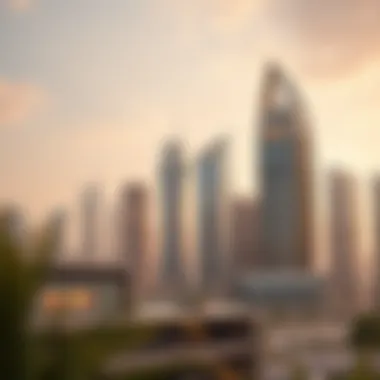
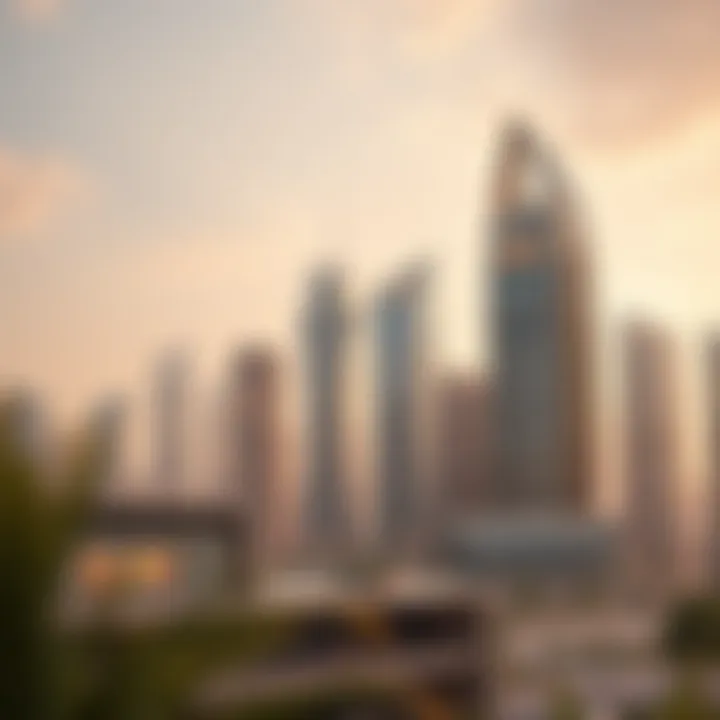
The incorporation of cutting-edge technologies in Dubai's construction projects is paving the way for smarter, more sustainable urban environments. Technologies such as Building Information Modeling (BIM), augmented reality, and artificial intelligence are becoming increasingly prevalent, facilitating everything from project design to maintenance.
- Building Information Modeling (BIM): By creating a virtual representation of a building, architects and engineers can foresee potential issues before they arise, significantly minimizing delays and costs. This technology aids investors in making informed decisions by providing a comprehensive visual of projects ahead of time.
- Augmented Reality (AR): This technology is enhancing real estate marketing and design processes. Developers can showcase virtual walkthroughs of yet-to-be-built properties, allowing potential buyers to immerse themselves in the living space with just a pair of VR glasses.
- Artificial Intelligence (AI): AI algorithms are streamlining everything from project management to material sourcing. For instance, AI can predict project risks and offer solution pathways that enhance efficiency. In a fast-paced city like Dubai, this capability can be a game changer.
The link between these technologies and environmental sustainability cannot be overstated. With global warming a pressing concern, green construction practices stand out. Technologies that improve energy efficiency during a building's lifecycle are becoming non-negotiable as investors increasingly seek to align with sustainable practices.
Urban Planning Initiatives
Urban planning in Dubai is transforming, with a stronger focus on creating livable spaces that cater to its diverse population. Initiatives in this sector emphasize the integration of lifestyle, work, and leisure within urban settings, ensuring that growth does not compromise quality of life.
- Smart City Initiatives: Dubai's government has initiated various programs aimed at implementing smart city solutions across the emirate. These include intelligent transportation systems that reduce congestion and enhance the flow of people and goods.
- Walkable Neighborhoods: Developments such as the Dubai Creek Harbour reflect a growing trend towards walkability. These projects prioritize pedestrian pathways, parks, and community amenities, ensuring residents have easy access to services and green spaces.
- Mixed-Use Developments: By combining residential, commercial, and recreational spaces, mixed-use developments are creating vibrant communities. Projects like The Dubai Mall and various waterfront developments exemplify this trend, encouraging social interaction and reducing the reliance on private vehicles.
The essence of these urban planning initiatives is to create a harmonious balance between development and sustainability. As Dubai continues to grow, the focus on intelligent, inclusive designs will help ensure that its construction projects resonate with the needs and desires of its residents.
"Dubai's construction scene is not just about creating structures; it's about crafting communities that will thrive for generations to come."
Investment Opportunities in New Projects
The current construction landscape in Dubai represents a trove of investment opportunities that are not just noteworthy but hold substantial potential for both seasoned investors and newcomers alike. With its rapidly evolving real estate scene, the emirate is calling for careful consideration of where one's capital could yield substantial returns.
As more and more innovative projects come to life, it becomes evident that several sectors are ripe for investment. This can range from hospitality and mixed-use developments to residential and commercial spaces, each bringing its own unique promise of profit.
Target Sectors for Investors
When looking to invest in Dubai's construction projects, certain sectors stand out due to their growth potential and strategic importance. Here is a closer look at them:
- Hospitality: With tourism skyrocketing, investments in luxury hotels and resorts present exciting returns. High-profile events, such as Expo 2020, have cemented Dubai's reputation as a tourist magnet.
- Residential Developments: The demand for housing, both luxury and affordable, continually outpaces supply. Investing in residential towers or community developments can tap into the housing shortage in some areas.
- Commercial Real Estate: The increase in business ventures and companies establishing a base in Dubai makes office spaces a lucrative sector. Co-working and flexible spaces are also becoming increasingly popular among startups and freelancers.
- Mixed-Use Developments: These projects blend residential, commercial and hospitality spaces into one, creating vibrant community hubs. Investors find that such developments often attract steady foot traffic and long-term tenants.
It's crucial for investors to do their homework in these sectors to identify the opportunities that align with their goals and risk tolerances. Partnering with local real estate experts or institutions can provide insights that may otherwise be challenging to obtain.
Risk Assessment and Management
Investing in construction projects inherently carries risks, particularly in a fluctuating market like Dubai’s. Therefore, a thorough risk assessment is fundamental to safeguarding investments. Here are some essential risk factors and management strategies:
- Market Volatility: Real estate markets can shift drastically. Staying informed about economic indicators, such as GDP growth rates and population trends in Dubai, can guide investment decisions.
- Regulatory Challenges: Navigating local laws and regulations can be complex. Investors should seek legal counsel to comply with Dubai's ever-evolving building codes and property laws.
- Construction Delays: Delays can derail financial forecasts. It is advisable to monitor project timelines and choose to invest in firms with a solid track record of completing projects on time.
- Financial Stability of Partners: Before entering partnerships, reviewing financial backgrounds is essential. Strong, financially stable partners can help mitigate risks effectively.
"The key to successful investment in construction lies in understanding not only the opportunities that lie ahead but also the risks that can come with them."
Ending
In the rapidly evolving skyline of Dubai, understanding the construction landscape is crucial for investors, home buyers, and property managers alike. The significance of this topic transcends mere architectural advancements; it encapsulates economic growth, urban development, and innovative sustainability practices. Each construction project not only alters the city's aesthetic but also influences its socio-economic fabric.
Summary of Findings
Through this exploration, we've gathered various insights:
- Ambitious Projects: Developments like the Dubai Creek Tower and the Museum of the Future exemplify how the city continues to push the envelope in construction scale and ambition. These projects serve as landmarks that enhance Dubai’s reputation on the global stage.
- Economic Benefits: As evidenced by the job creation statistics, the building boom correlates with lower unemployment rates and better wages in the construction sector. New jobs fostered in these initiatives not only support the construction workforce but permeate the entire economy.
- Technological Integration: The shift towards smart technology is indeed a game-changer. Building automation, energy efficiency, and eco-friendly materials are becoming industry standards, showcasing the city’s commitment to sustainability, which is particularly relevant in the context of climate challenges.
Understanding these points can empower stakeholders with key knowledge needed to navigate the complexities of the real estate market in Dubai.
Final Thoughts on the Future of Construction in Dubai
Looking ahead, the future of construction in Dubai promises not only further architectural marvels but also a fundamental shift in how urban spaces are designed and utilized. Investors stand on the cusp of groundbreaking opportunities as projects like the Dubai 2040 Urban Master Plan unfold. This is set to reimagine the city’s landscape, emphasizing green spaces and enhancing community living.
Such projects reflect a broader trend towards integrated urban planning, where every building serves a purpose beyond its walls—creating connections among residents, businesses, and the rich cultural tapestry that defines Dubai.
As Dubai strides confidently into a new era of construction, it is imperative for those invested in this market to remain informed. Keeping an eye on innovations, regulatory changes, and emerging trends is essential. In this way, stakeholders can not only contribute to but also benefit from the remarkable changes taking place in this vibrant city.
"The art of progress is to preserve order amid change and to preserve change amid order."
— Alfred North Whitehead













